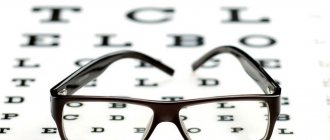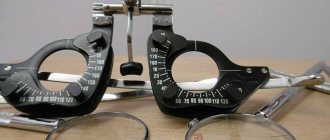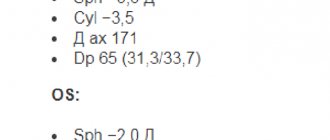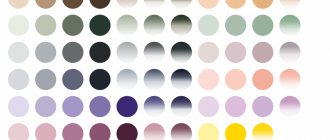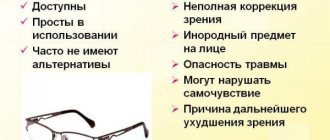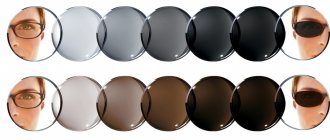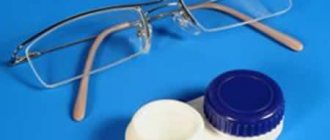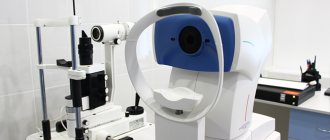If a person’s visual acuity begins to decrease, he will not be able to choose glasses on his own. To do this, it is necessary to identify the main indicators of the eyeballs and their refractive ability.
To correctly determine the indicators, you need to get a prescription for glasses from an ophthalmologist.
It contains the basic designations in Latin letters, with certain numbers next to them that differ for each patient. Such actions are necessary in order to identify the individual characteristics of ophthalmological parameters for each person.
How to decipher a prescription for glasses
The ophthalmologist undergoes basic diagnostic tests:
- table for identifying visual acuity - it contains letters or pictures that a person determines only with each eye separately, the more lines he sees, the better his visual acuity;
- autorefractometry – refractive ability is determined for each eye separately, as well as additional criteria for the eyeballs, for example, the distance between the pupils;
- Ultrasound of the eyeballs to identify the location and normal structure of each intraocular element;
- ophthalmological perimeter - determination of normality or impairment of lateral vision;
- examination of the fundus – determination of the structure of intraocular elements using visual examination after drug dilation of the pupil.
These are the main diagnostic tests. If the doctor suspects any disease, he may prescribe additional research methods. For example, measuring intraocular pressure, angiography.
After all the tests have been completed, the patient receives a prescription for glasses. It displays indicators using abbreviations. Their decoding is in the table below.
| Abbreviation | Decoding |
| O.D. | Designation of the indicator for the right eye. The values are written on the left side of the form |
| OS | Designation for the left eye. Information for this organ of vision is prescribed a little lower after the right eye |
| OU | Values described for both eyes simultaneously. This is necessary when any adjustment is required for two organs of vision at once. |
| Sph | Optical power, that is, an indicator that determines the necessary adjustment of the patient’s visual acuity. The number is expressed in diopters and can be positive for myopia, or negative for hypermetropia. This is the most important part of the glasses prescription, which is used to select lenses. |
| Cyl | This designation is used for the optical gain required for a cylindrical lens. It is used to select lenses that are necessary to correct astigmatism. |
| Prism | The physician points to this designation if the patient needs to be fitted with a prism lens. This type of lens is suitable for people suffering from myopia |
| Ax | This measurement is carried out in degrees in the range from 0 to 180. The indicator is necessary for the cylindrical tilt of the lens |
| Add | An indicator indicating the difference between the closest and farthest point at which a person can see well. Its measurement is necessary to select bifocal or progressive glasses when a person has both myopia and hypermetropia. That is, he sees poorly near and far. This condition develops after the age of 40 due to presbyopia (age-related changes in the organs of vision) |
| Dd | This is an indicator indicating the distance between the two pupils when the gaze is located strictly in the center. The value is necessary to correctly select the center of the lens for glasses |
After receiving the glasses prescription form, you must take it to the optician. There, a specialist will select a suitable frame, and the lenses will be made according to the data received.
Other abbreviations
When filling out the form, other abbreviations corresponding to Latin medical terms are also used:
- Sph (sphere) is translated as sphere. This term refers to the correction ability of a lens, that is, its optical power. In this case, there may be a + sign or a - sign, which depends on whether the patient is nearsighted or farsighted. This parameter is expressed in diopters. Depending on the optical power of the lens, it depends on whether glasses will help correct myopia, presbyopia, and farsightedness. The medical term myopia refers to nearsightedness. This disease is corrected using diverging lenses. Doctors usually call farsightedness hypermetropia. To correct this disease, special converging lenses are used.
- Cyl (cylinder) corresponds to the power of the lens, which helps eliminate signs of astigmatism. It is also indicated by a + or - sign. When the geometry of the surface layers of the cornea is disrupted, a disease called astigmatism occurs. As a result, the uniform distribution of refractive power along the meridians is disrupted. To correct this pathology, cylindrical lenses are used.
- The position of the axis is measured in degrees, and its value ranges from 0 to 180. This phenomenon is associated with the refraction of light rays that pass through the lens. In order for a similar transformation to occur with a beam, it must approach the axes at 90 degrees, as a result of which it is possible to correct the refractive power for rays in a strictly specified meridian. To determine the meridian, a certain and specific scale is applied to the eye, which is built into the frame sample. The term TABO is used to refer to this system.
- Ax (Axis) corresponds to the inclination of the axis in the cylinder and is an excellent opportunity for vision correction in a specific meridian. Dp (distantio pupillorum) is measured in millimeters and corresponds to the distance between the pupils.
- Add (addition) is determined between the zones of existing vision, which plays a role in the correction of presbyopia. This indicator is expressed in diopters, reaching a maximum of +3 units.
- Prism corresponds to the lens power used to correct strabismus. This parameter is also expressed in diopters. Now let's give an example of deciphering a prescription for glasses:
- OD Sph −3.0 D Cyl −2.0 D ax 179
- OS Sph −3.6 D Cyl −3.0 D ax 172
- Dp 66 (32.3/33.7)
First, let's read the data for the right eye, which helps to cope with myopia. The patient requires a lens with an optical power of 3 diopters. To eliminate the symptoms of astigmatism, a lens is used whose axis is 179 degrees and the power is 2 diopters.
As for the left eye, a myopia-correcting lens with an optical power of 3.6 diopters is required. To correct signs of astigmatism, you need a lens with an axis of 172 degrees and a power of 3 diopters.
The last line indicates the interpupillary distance, which in this case is 66 mm.
What does a glasses prescription look like?
A sample prescription for glasses looks like this:
Left eye. Based on the prescription received, we can say that the person taking the test suffers from myopia. That is, he sees well up close, but poorly at a distance. His visual acuity is -2 diopters. The patient also suffers from astigmatism, so it is necessary to choose toric lenses. Their refractive power should be 2.5 diopters.
Right eye. The condition of the right eye is slightly worse. The optical power is 3.8 diopters. This eye also suffers from astigmatism, which requires a toric lens with a refractive power of 3.5 diopters.
The distance between the pupils is indicated on the glasses prescription form. It should be approximately 65 mm.
Selection of glasses according to prescription
Since there are many ophthalmological diseases that contribute to a decrease in visual acuity, you should strictly take into account your glasses prescription. They can be used for distant, near or simultaneous development of these conditions. Also, many patients experience astigmatism, in which the shape of the eyeballs is changed. This pathology is also corrected with spectacle lenses.
For distance
Such glasses must be worn constantly, since people suffering from myopia will not be able to view objects around them without an optical aid. Glasses for driving a vehicle may be prescribed separately. They can be coated with a special coating that protects against glare on the road.
Lenses that correct only myopia are defined as monofocal.
For up close
The condition that requires glasses for near vision is called hypermetropia. Most often they are needed only for reading or using the computer. They are used on a temporary basis. Such lenses are also monofocal, that is, the refractive power is the same for the entire optical device.
Progressive
Such lenses are necessary for people with presbyopia, that is, aging changes in the eyes. People see poorly both near and far at the same time, that is, myopia and hypermetropia are combined. To correct such vision, it is necessary to use special lenses.
At the top they include lenses necessary for viewing objects in the distance, at the bottom - near. Between these two points there is a transition part, with the help of which the eyes gradually get used to the change in refraction. There is no viewing on the sides of these lenses; there is no curvature there.
The disadvantage of progressive glasses is the adaptation period. Some categories of patients will never be able to pass it.
How is visual acuity tested?
The accuracy of your glasses prescription is very important, and since it depends on the examination, the patient should tell the doctor about all the features of his vision. If you have any unpleasant symptoms or eye fatigue, this should also be mentioned.
If the patient already has glasses or contact lenses, the previous prescription should be taken with you and shown to the ophthalmologist so that the doctor takes into account their features when selecting new ones. It is necessary to decide in advance for what purposes you need glasses. Special filters against glare and ultraviolet radiation can be added to the lenses.
The drugs used that affect the organs of vision are also taken into account. These include antidepressants, tranquilizers, oral contraceptives, antiarrhythmic drugs, antipsychotics, calcium channel blockers (prescribed for heart pathologies), drugs for psoriasis, diuretics (thiazide). They may make your eyes more sensitive to light.
Medicines that dilate the pupil:
- anticholinergic drugs (atropine);
- tetracycline and fluoroquinolone antibiotics;
- scopolamine;
- anticonvulsants (phenytoin);
- antihistamines;
- antidepressants;
- central nervous system stimulants;
- sedatives;
- drugs for impotence;
- phenothiazines.
Working with tables
Making glasses
After receiving your glasses prescription, you must submit it to the optician. It will produce lenses that will be inserted into the frame chosen by the person. The manufacturing process takes place over several weeks, so must be taken into account by humans.
The frame must also be tailored to the individual. Therefore, before purchasing glasses, you should try them on. It should not interfere with conversation, eating, or movement. Glasses should sit firmly on your face and not fall off.
Where to buy glasses
Glasses can be bought at any optician. There may also be an ophthalmologist in it, from whom you can undergo all diagnostic tests after receiving a prescription for an optical product. The order is made on the spot, so time is saved.
After receiving the glasses at the optical salon, you should try them on again; it is important to check the quality of the fittings, frames, and lenses. Using glasses to view objects close up, a person should clearly see all the lines written in the text at any distance. If glasses for distance viewing are received, the patient must examine all the lines in the diagnostic table.
How is visual acuity tested?
An ophthalmologist can make a prescription for glasses only based on the results of the examination.
Usually, checking visual acuity using a standard table is enough, but only in the doctor’s office are all conditions met (distance, lighting, contrast, size of symbols). The doctor also determines the strength of the lenses to help correct vision for a particular patient, using different options from a special set and a trial frame. You can undergo an vision test and get a prescription for glasses in a city clinic, private ophthalmology offices and even in optical salons. It is not recommended to select glasses on your own, as unsuitable ones will contribute to worsening vision and rapid visual fatigue.
For prevention purposes, children's vision should be checked immediately after birth, at 6 months and 3 years. From 4 to 18 years of age, you should visit an ophthalmologist annually. People from 19 to 64 years old can get checked every 2 years, and after 65 it is advisable to see a doctor every 6-12 months, as the risk of cataracts increases.
Working with tables
Visual acuity is the ability of the eye to distinguish small details from different distances and under different lighting conditions. The cause of decreased vision can be hereditary and acquired diseases. It is also necessary to take into account age-related changes in the visual organs.
A standard visual acuity test is the basis for diagnosing ophthalmological diseases. It includes the study of visual capabilities at different distances, the analysis of color perception and the study of visual fields. To test vision, tables with symbols and standard lighting are used (Golovin-Sivtsev table and Landolt rings for adults, Orlova table for children).
The standard table has 12 rows where letters and signs of different sizes are located. The size of the symbols differs from row to row, but in one row they are all the same size. In the first ten rows, adjacent symbols differ by 0.1 units, and in the last by 0.5 units.
When using the standard Golovin-Sivtsev table, the patient is placed 5 meters from the object. If a person distinguishes characters in the tenth row, his vision is considered normal and is equal to 1. Visual acuity indicators for each row are indicated directly on the table.
Rules for checking vision according to the table:
- The study is carried out separately for each eye.
- The test begins with the right eye.
- Both eyes should remain open, but the other should be covered with a shield or palm. The shield should be held in front of the eye so as to exclude the possibility of unintentional peeking.
- During the examination, you should not squint, because this helps improve vision in case of myopia.
- You need to keep your head level.
- During a normal test, a person should be able to distinguish the symbol in 2-3 seconds. During the control study - in 4-5 seconds.
- You need to point at the symbols with a regular or laser pointer.
- The check begins from the 10th row, moving to larger symbols.
- For patients with visual impairments, the check begins from the top row, one character in each. If an error occurs in any row, the patient must read all the letters of the previous one.
- Visual acuity is assessed by the series from which all the letters were correctly named. An error is allowed in rows 3-6 and two errors in rows 7-10.
Near vision is tested using a card with several paragraphs of text. In each of them the letters have different sizes. The text is read from a distance of 33-35 cm. With normal vision, a person is able to read a paragraph corresponding to a unit of visual acuity. If during the test the visual acuity is below normal, the ophthalmologist begins a refraction test.
At this stage, the doctor puts a trial frame on the patient and inserts diagnostic lenses, simultaneously checking visual acuity using a table. This allows you to more accurately determine the required correction force. The optometrist tries the lenses sequentially, increasing the number of diopters until maximum visual acuity is achieved.
For nearsightedness, first try a lens with minimal refraction, and for farsightedness - with maximum power. At the end, a binocular test is performed, that is, both eyes at once. Visual acuity in each eye should be 0.9-1 unit according to the table.
For astigmatism, it is important to determine the type and degree of impairment, as well as the spherical and astigmatic components of correction. The ophthalmologist must select the position of the lens axis to ensure maximum visual acuity. For this purpose, astigmatic figures and crossed cylinders are used.
The study with astigmatic figures is based on the fact that the eye with astigmatism sees lines of different orientations in such figures unevenly. Crossed cylinders help clarify the degree of astigmatism, as well as the strength and direction of the cylinder axis in glasses.
The distance between the centers of the pupils is measured after selecting lenses. A pupillometer is designed for this, but an experienced ophthalmologist can measure the distance using a regular ruler. In fully equipped ophthalmology offices, interpupillary distance is measured using electronic systems that guarantee absolute accuracy.
The interpupillary distance is necessary for proper lens centering. Incorrect alignment can increase visual strain and cause symptoms of eye strain. Prescriptions for regular glasses indicate the distance for both eyes, and when making progressive and aspheric lenses, the monocular pupillary distance is also taken into account.
